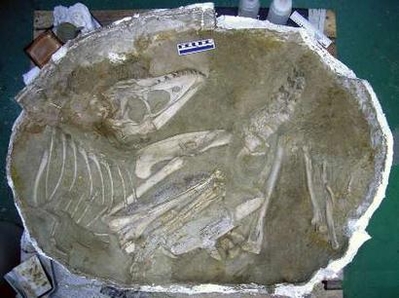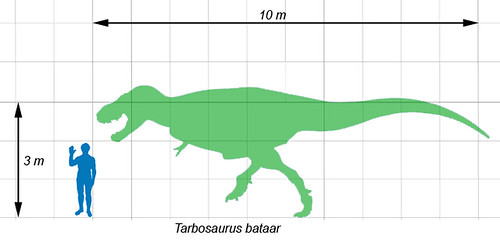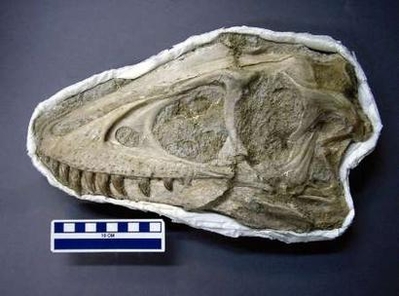tags: dinosaurs, Tarbosaurus bataar, paleontology, fossils, Tyrannosaurs rex
Discovered in 2006, a near-perfect complete skeleton of a juvenile Tarbosaurus find was made available for public viewing for the first time today by the Hayashibara Museum of Natural Science in Okayama, western Japan. This fossil was originally unearthed from a chunk of sandstone in the Gobi Desert of Mongolia by a team of Mongolian and Japanese researchers. The fossil of the young dinosaur is roughly 70 million years old (from the late Cretaceous period) and is the first time that this species has been found "totally intact".
"We were so lucky to have found remains that turned out to be a complete set of all the important parts," said Takuji Yokoyama, a spokesman for the Hayashibara Museum of Natural Sciences, a co-organizer of the joint research project.
Young dinosaurs were usually destroyed by weather or scavengers long before they became fossilized, so this juvenile is a rare find. This fossil is more than 80 percent complete, apparently lacking only the animal's neck bones and the tip of its tail. The dinosaur is estimated to have been five years old when it died. It is approximately 6.5 feet long, while adults of the species reach 40 feet in length and weighed roughly five tons.
Tarbosaurus ("alarming lizard") are relatives of Tyrannosaurus rex, although some paleontologists consider them to be synonymous. However, because Tyrannosaurus was native to North America, while Tarbosaurus ranged throughout Asia, other researchers consider the two genera to be distinct, although closely related.
Tarbosaurus are well-represented in the fossil record, and several complete skulls have been found. As a result, scientists have been able to carefully study its jaw mechanics, brain structure and to determine its taxonomy;
Based on their analyses, scientists found that Tarbosaurus and Tyrannosaurus skulls differ only in the positions of several cranial nerve roots, but otherwise, they are remarkably similar.
Skull analyses have also provided a few glimpses into the animal's natural history and conclude that Tarbosaurus played a similar ecological role in Asia as Tyrannosaurus did in North America. For example, Tarbosaurus had both a good sense of smell and binocular vision, which would have made it an effective hunter. Other fossil evidence suggests that this animal could have been social and might have hunted in packs.
The discovery of this juvenile Tarbosaurus will provide scientists with the unusual opportunity to learn more about the development and growth rates of young dinosaurs, as suggested by this side-by-side comparison of toes from the newly unveiled young animal to that of an adult of the species;
A cleaned and prepared toe from the newly-unveiled juvenile Tarbosaurus compared to the same toe from an adult of the species.
The team of fossil hunters are a group of scientists from the biotechnology firm, Hayashibara, which has been conducting research in the desert since 1993, and from the Mongolian Academy of Sciences.
Source
AP (quote).
- Log in to post comments






The AP story managed to get it right that Tarbosaurus is related to Tyrannosaurus. Too bad Reuters couldn't quite put that together in a way that wasn't awkward. ;-)